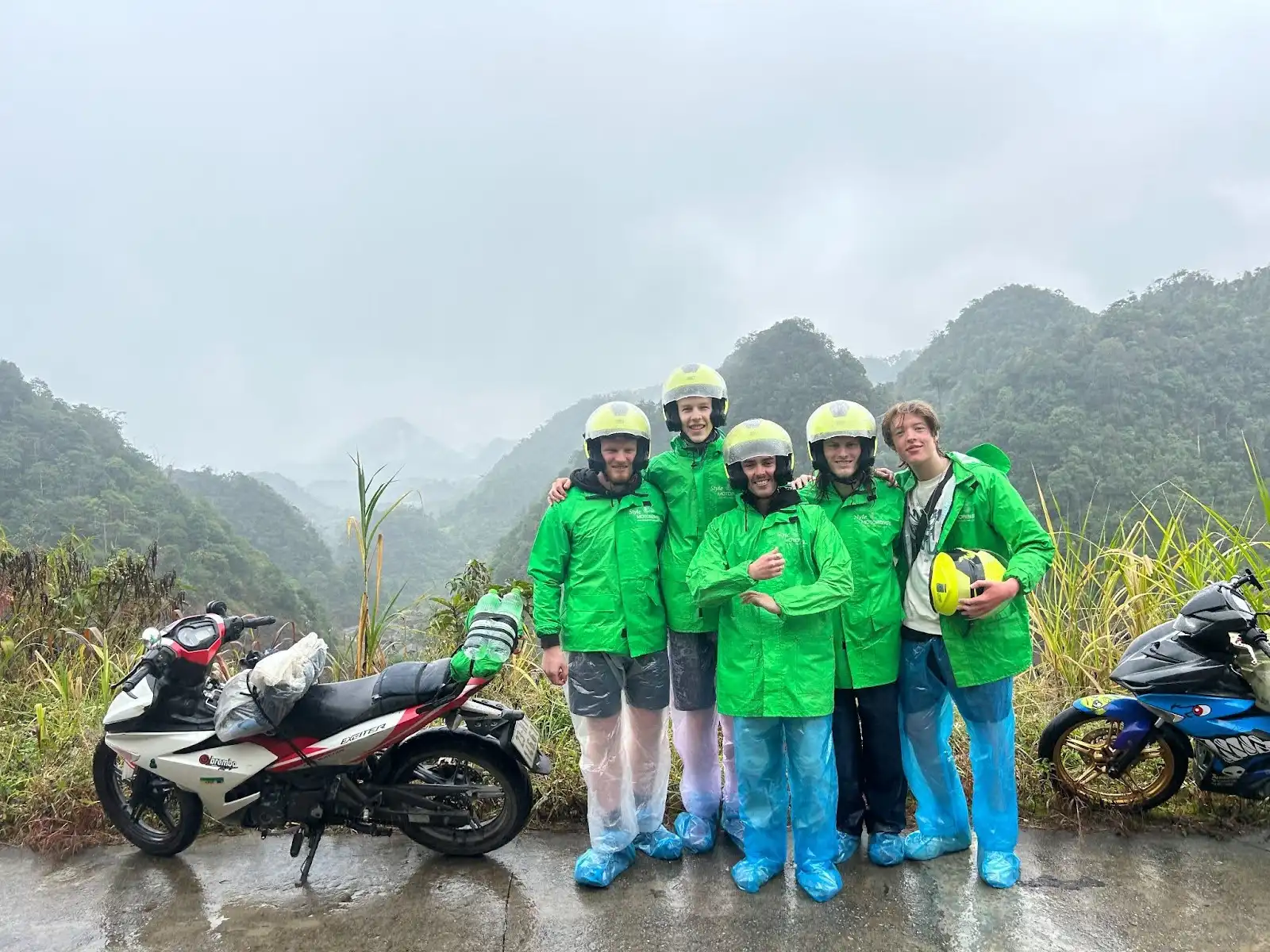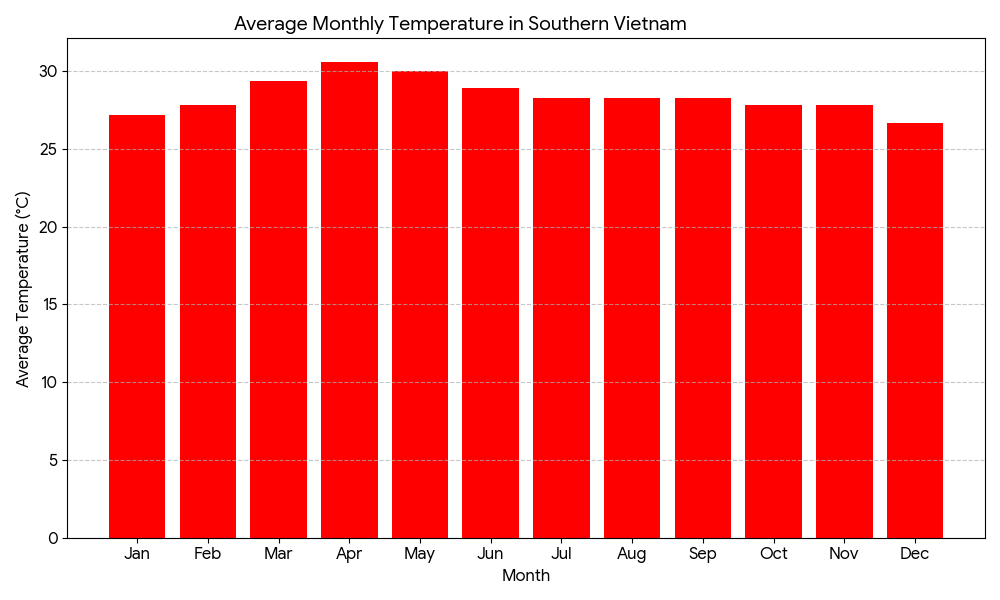Vietnam Weather – The Best Time to Ride in Vietnam
The weather in Vietnam plays a huge role in shaping your motorbike adventure. With the country stretching over 1,600 km from north to south, the climate varies dramatically between regions. To plan the perfect ride, it’s important to understand when and where to go – especially if you’re riding long distances such as the Ha Giang Loop, the Central Coast, or Ho Chi Minh Trail.
Vietnam can be divided into three main weather regions:
- Northern Vietnam – Four distinct seasons (spring, summer, autumn, winter)
- Central Vietnam – Consistently warm with a heavy rainy season
- Southern Vietnam – Tropical climate with wet and dry seasons

The 4 Seasons of the North of Vietnam
Northern Vietnam (including Hanoi, Ha Giang, and Sapa) has the most variation in weather. It’s the only region with four distinct seasons – making timing your trip very important.
Northern Summer (May – September)
The summer months bring hot and humid weather with temperatures averaging around 30°C (85°F). In the mountains, such as Ha Giang, it’s slightly cooler, while in cities and lowlands it can feel sweltering due to the humidity.
This is also the rainy season, with heavy downpours from June to September (250mm per month on average). While the rain usually comes in short bursts, the combination of heat, humidity, and wet roads makes this the most challenging time to ride.
Best for: Experienced riders used to tropical heat.
Not ideal for: Beginners or those seeking dry conditions.

Northern Winter (November – March)
The winter in the north surprises many travelers – it can get quite cold, especially in the mountains. Daytime temperatures often drop to 15°C (59°F), and nights in Ha Giang or Sapa can fall below 10°C (50°F).
However, this is also the driest season, making it the best time to ride the Ha Giang Loop if you’re prepared for the cold. Warm gear – including gloves, jackets, and layers – is essential.
Average Rainfall: Only 150mm over five months.
Best for: Dry, scenic rides and clear skies.
Tip: Accommodation and roads are busiest during this season.
Spring in the North (February – April)
Spring offers the most pleasant riding weather of the year. The temperature climbs gradually from 18°C (64°F) in February to around 24°C (75°F) in April.
Rain is still light, and the landscapes are lush and green from the previous rains – perfect for scenic photography. March, with minimal rain (about 34mm), is often considered the best month to ride in northern Vietnam.
Best for: Comfortable temperatures and vibrant scenery.

Autumn in the North (September – November)
Autumn begins as the rains ease off and the heat fades. September can still be wet, but by October and November, the weather is dry, cool, and ideal for motorbike travel.
This period also coincides with the start of the peak tourism season, so expect busier roads and higher demand for motorbike rentals.
Best for: Clear views, harvest season landscapes, and smooth dry rides.
The Wet & Dry Season of Southern Vietnam
Southern Vietnam (including Ho Chi Minh City, Mui Ne, and Phu Quoc) enjoys warm temperatures year-round, typically between 27-32°C (81-90°F). The key difference between seasons here is rainfall, not temperature.

The Dry Season (November – April)
The dry season is the best time to ride in southern Vietnam, with clear skies, warm days, and minimal rain. This is also the peak tourist season, so it’s wise to book your motorbike in advance, especially in Ho Chi Minh City.
Perfect for: Long-distance rides, coastal routes, and exploring the Mekong Delta.

The Wet Season (May – October)
During the wet season, afternoon showers are common but often short-lived. Rainfall is less intense than in central Vietnam and manageable for experienced riders.
If you’re escaping the rainy north or central regions, the south can still offer decent riding days even during this time.
Tip: Bring waterproof clothing – tropical downpours can arrive suddenly.
Central Vietnam Weather – The Unpredictable Rainy Season
Central Vietnam (including Hoi An, Hue, Da Nang, and Phong Nha) is known for its extreme rainy season, which can disrupt travel plans if timed poorly.

The Rainy Season September – January
Rain peaks in October, when monthly rainfall can be double or even triple that of other regions. Flooding can occur in low-lying areas such as Hue and Hoi An. Rain often lasts all day, unlike the short bursts in the north.
Tip: If traveling through Vietnam north-to-south, consider skipping the central section by bus or train during these months.
The Dry Season (February – August)
From February to August, Central Vietnam is warm and mostly dry, making it ideal for exploring the Hai Van Pass, Marble Mountains, and the coastal roads.
Best for: Smooth rides and sunny beach detours between Hue and Hoi An.
Summary
If you’re planning a motorbike trip across Vietnam, understanding the weather is essential to choosing the best time to ride. The country’s long, narrow shape means conditions can change drastically from north to south – so what’s perfect weather in one region could mean storms in another.
For riders doing the entire length of Vietnam, from Hanoi to Ho Chi Minh City (or vice versa), the ideal window is from December through to March. During these months, temperatures across the country are generally comfortable, humidity is lower, and rainfall is at its minimum. The north can be cool or even cold – especially in the mountains like Ha Giang or Sapa – but it’s also dry and clear, making it a great time for scenic rides. Bring warm gear, as mornings and evenings can drop sharply in temperature.
If you’re only exploring Northern Vietnam, the best time is September to November and March to May, when you’ll enjoy pleasant temperatures, fewer tourists, and vibrant landscapes. Autumn (September – November) offers golden rice terraces and crisp mountain air – arguably the most beautiful season for the Ha Giang Loop and Northern Highlands. Spring (March – May) brings blooming flowers and clear skies, ideal for photography and smooth road conditions.
For Central Vietnam (Hue, Da Nang, Hoi An, and the Hai Van Pass), the key is to avoid the rainy season from September to January, when the region experiences heavy, prolonged rain and occasional flooding. The best months to ride this section are February to August, with February to April being especially ideal – warm, dry, and full of sunshine.
In Southern Vietnam, including Ho Chi Minh City, the Mekong Delta, and the beaches of Phu Quoc, the weather is far more consistent year-round. The dry season (November – April) is the best time for motorbike travel, with hot, sunny days and little rain. Even in the wet season (May – October), rain usually comes in short, heavy bursts, so it’s still possible to ride – especially if you plan your days well and have good rain gear.
If you’re planning to ride the entire country, you’ll likely experience multiple weather patterns – from the cool, dry mountains in the north to the tropical heat in the south. Many experienced riders time their journey to start in the south around November – December, then head north gradually through the winter months, arriving as the northern weather starts warming up in March or April. This allows you to follow the best conditions as you move through Vietnam.
In short:
- Best overall months to ride Vietnam: December – March
- Best time for the North: September – November and March – May
- Best time for the Centre: February – August
- Best time for the South: November – April
With the right timing, Vietnam offers some of the most rewarding motorbike riding in the world – from misty mountain passes to sunny coastal highways, lush jungles, and remote ethnic villages. No matter the season, if you’re prepared for the elements, every ride promises unforgettable views, culture, and adventure
Reviews
Share your experience and help other ridersNo reviews yet. Be the first to review!

Leave a Comment & Review